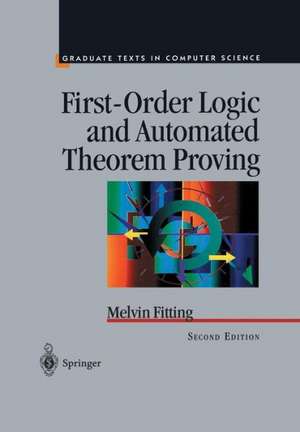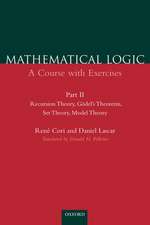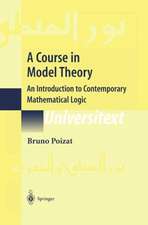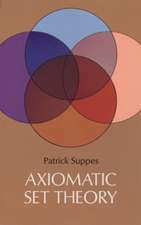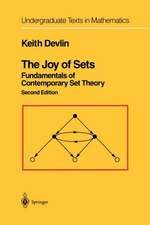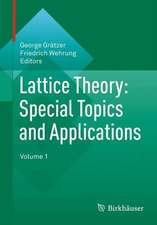First-Order Logic and Automated Theorem Proving: Texts in Computer Science
Autor Melvin Fittingen Limba Engleză Paperback – 26 iun 2013
Din seria Texts in Computer Science
- 20%
 Preț: 366.94 lei
Preț: 366.94 lei - 20%
 Preț: 675.36 lei
Preț: 675.36 lei - 20%
 Preț: 411.53 lei
Preț: 411.53 lei - 20%
 Preț: 411.75 lei
Preț: 411.75 lei - 20%
 Preț: 306.37 lei
Preț: 306.37 lei - 20%
 Preț: 474.58 lei
Preț: 474.58 lei - 20%
 Preț: 1244.39 lei
Preț: 1244.39 lei - 20%
 Preț: 370.59 lei
Preț: 370.59 lei - 20%
 Preț: 379.65 lei
Preț: 379.65 lei - 20%
 Preț: 444.93 lei
Preț: 444.93 lei - 20%
 Preț: 305.31 lei
Preț: 305.31 lei - 20%
 Preț: 406.21 lei
Preț: 406.21 lei - 20%
 Preț: 503.88 lei
Preț: 503.88 lei - 20%
 Preț: 370.23 lei
Preț: 370.23 lei - 17%
 Preț: 366.70 lei
Preț: 366.70 lei - 20%
 Preț: 423.53 lei
Preț: 423.53 lei - 20%
 Preț: 441.71 lei
Preț: 441.71 lei - 20%
 Preț: 515.36 lei
Preț: 515.36 lei - 15%
 Preț: 637.58 lei
Preț: 637.58 lei - 20%
 Preț: 353.34 lei
Preț: 353.34 lei - 20%
 Preț: 356.82 lei
Preț: 356.82 lei - 20%
 Preț: 181.92 lei
Preț: 181.92 lei - 20%
 Preț: 330.42 lei
Preț: 330.42 lei - 20%
 Preț: 743.62 lei
Preț: 743.62 lei - 20%
 Preț: 663.45 lei
Preț: 663.45 lei -
 Preț: 457.75 lei
Preț: 457.75 lei - 20%
 Preț: 536.66 lei
Preț: 536.66 lei - 20%
 Preț: 358.24 lei
Preț: 358.24 lei -
 Preț: 385.84 lei
Preț: 385.84 lei - 20%
 Preț: 394.57 lei
Preț: 394.57 lei - 20%
 Preț: 344.76 lei
Preț: 344.76 lei - 20%
 Preț: 621.18 lei
Preț: 621.18 lei - 20%
 Preț: 350.86 lei
Preț: 350.86 lei - 20%
 Preț: 348.89 lei
Preț: 348.89 lei - 20%
 Preț: 339.95 lei
Preț: 339.95 lei - 20%
 Preț: 588.21 lei
Preț: 588.21 lei - 20%
 Preț: 199.57 lei
Preț: 199.57 lei - 20%
 Preț: 341.30 lei
Preț: 341.30 lei - 23%
 Preț: 726.94 lei
Preț: 726.94 lei - 20%
 Preț: 325.30 lei
Preț: 325.30 lei - 20%
 Preț: 595.80 lei
Preț: 595.80 lei -
 Preț: 454.31 lei
Preț: 454.31 lei
Preț: 593.48 lei
Preț vechi: 741.85 lei
-20% Nou
Puncte Express: 890
Preț estimativ în valută:
113.60€ • 123.43$ • 95.48£
113.60€ • 123.43$ • 95.48£
Carte tipărită la comandă
Livrare economică 21 aprilie-05 mai
Preluare comenzi: 021 569.72.76
Specificații
ISBN-13: 9781461275152
ISBN-10: 1461275156
Pagini: 348
Ilustrații: XVIII, 326 p.
Dimensiuni: 170 x 244 x 18 mm
Greutate: 0.55 kg
Ediția:2nd ed. 1996. Softcover reprint of the original 2nd ed. 1996
Editura: Springer
Colecția Springer
Seria Texts in Computer Science
Locul publicării:New York, NY, United States
ISBN-10: 1461275156
Pagini: 348
Ilustrații: XVIII, 326 p.
Dimensiuni: 170 x 244 x 18 mm
Greutate: 0.55 kg
Ediția:2nd ed. 1996. Softcover reprint of the original 2nd ed. 1996
Editura: Springer
Colecția Springer
Seria Texts in Computer Science
Locul publicării:New York, NY, United States
Public țintă
GraduateCuprins
1 Background.- 2 Propositional Logic.- 2.1 Introduction.- 2.2 Propositional Logic—Syntax.- 2.3 Propositional Logic—Semantics.- 2.4 Boolean Valuations.- 2.5 The Replacement Theorem.- 2.6 Uniform Notation.- 2.7 König’s Lemma.- 2.8 Normal Forms.- 2.9 Normal Form Implementations.- 3 Semantic Tableaux and Resolution.- 3.1 Propositional Semantic Tableaux.- 3.2 Propositional Tableaux Implementations.- 3.3 Propositional Resolution.- 3.4 Soundness.- 3.5 Hintikka’s Lemma.- 3.6 The Model Existence Theorem.- 3.7 Tableau and Resolution Completeness.- 3.8 Completeness With Restrictions.- 3.9 Propositional Consequence.- 4 Other Propositional Proof Procedures.- 4.1 Hilbert Systems.- 4.2 Natural Deduction.- 4.3 The Sequent Calculus.- 4.4 The Davis-Putnam Procedure.- 4.5 Computational Complexity.- 5 First-Order Logic.- 5.1 First-Order Logic—Syntax.- 5.2 Substitutions.- 5.3 First-Order Semantics.- 5.4 Herbrand Models.- 5.5 First-Order Uniform Notation.- 5.6 Hintikka’s Lemma.- 5.7 Parameters.- 5.8 The Model Existence Theorem.- 5.9 Applications.- 5.10 Logical Consequence.- 6 First-Order Proof Procedures.- 6.1 First-Order Semantic Tableaux.- 6.2 First-Order Resolution.- 6.3 Soundness.- 6.4 Completeness.- 6.5 Hilbert Systems.- 6.6 Natural Deduction and Gentzen Sequents.- 7 Implementing Tableaux and Resolution.- 7.1 What Next.- 7.2 Unification.- 7.3 Unification Implemented.- 7.4 Free-Variable Semantic Tableaux.- 7.5 A Tableau Implementation.- 7.6 Free-Variable Resolution.- 7.7 Soundness.- 7.8 Free-Variable Tableau Completeness.- 7.9 Free-Variable Resolution Completeness.- 8 Further First-Order Features.- 8.1 Introduction.- 8.2 The Replacement Theorem.- 8.3 Skolemization.- 8.4 Prenex Form.- 8.5 The AE-Calculus.- 8.6 Herbrand’s Theorem.- 8.7 Herbrand’s Theorem, Constructively.-8.8 Gentzen’s Theorem.- 8.9 Cut Elimination.- 8.10 Do Cuts Shorten Proofs?.- 8.11 Craig’s Interpolation Theorem.- 8.12 Craig’s Interpolation Theorem—Constructively.- 8.13 Beth’s Definability Theorem.- 8.14 Lyndon’s Homomorphism Theorem.- 9 Equality.- 9.1 Introduction.- 9.2 Syntax and Semantics.- 9.3 The Equality Axioms.- 9.4 Hintikka’s Lemma.- 9.5 The Model Existence Theorem.- 9.6 Consequences.- 9.7 Tableau and Resolution Systems.- 9.8 Alternate Tableau and Resolution Systems.- 9.9 A Free-Variable Tableau System With Equality.- 9.10 A Tableau Implementation With Equality.- 9.11 Paramodulation.- References.
